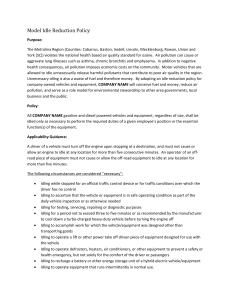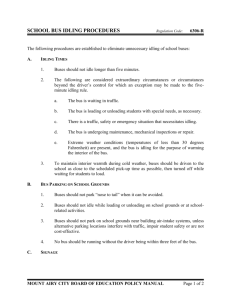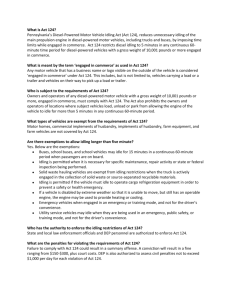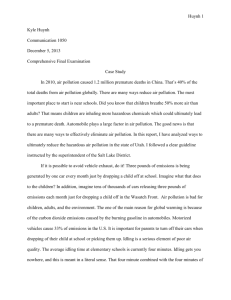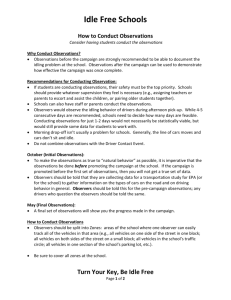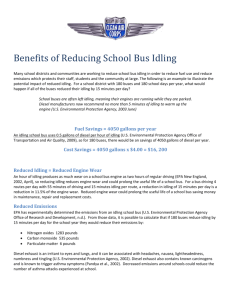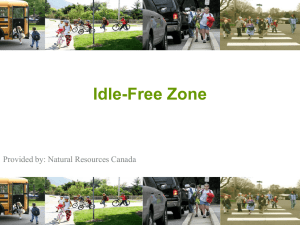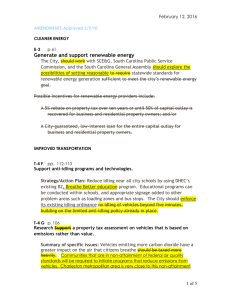What are you waiting for - Chicago Conservation Corps
advertisement
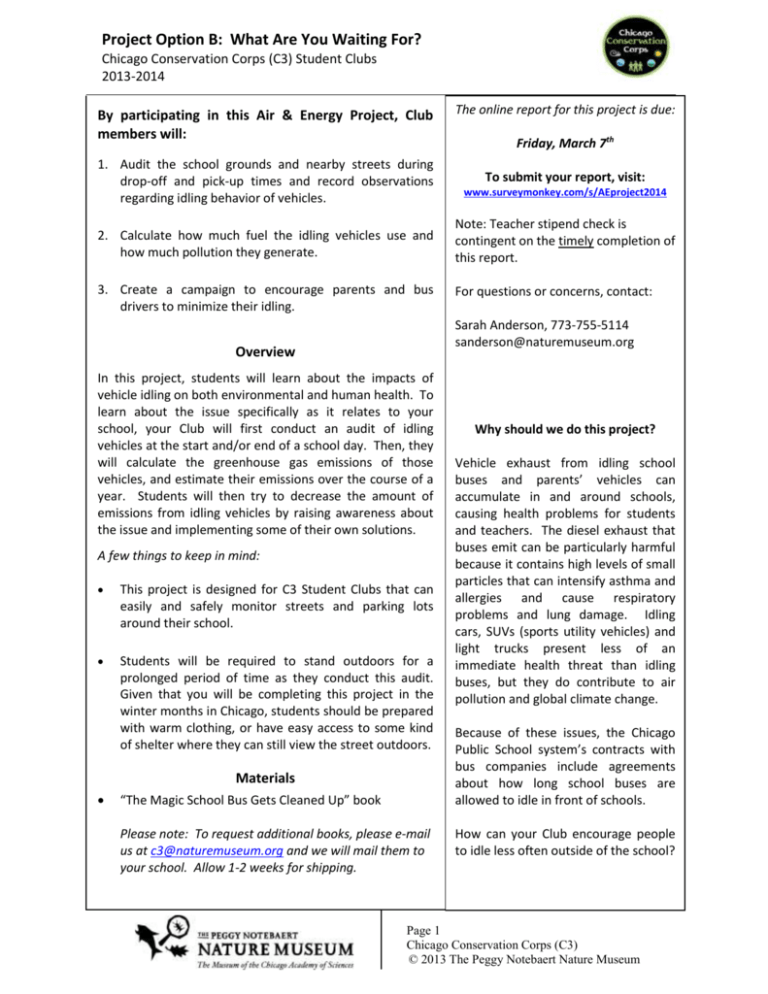
Project Option B: What Are You Waiting For? Chicago Conservation Corps (C3) Student Clubs 2013-2014 By participating in this Air & Energy Project, Club members will: 1. Audit the school grounds and nearby streets during drop-off and pick-up times and record observations regarding idling behavior of vehicles. The online report for this project is due: Friday, March 7th To submit your report, visit: www.surveymonkey.com/s/AEproject2014 2. Calculate how much fuel the idling vehicles use and how much pollution they generate. Note: Teacher stipend check is contingent on the timely completion of this report. 3. Create a campaign to encourage parents and bus drivers to minimize their idling. For questions or concerns, contact: Sarah Anderson, 773-755-5114 sanderson@naturemuseum.org Overview In this project, students will learn about the impacts of vehicle idling on both environmental and human health. To learn about the issue specifically as it relates to your school, your Club will first conduct an audit of idling vehicles at the start and/or end of a school day. Then, they will calculate the greenhouse gas emissions of those vehicles, and estimate their emissions over the course of a year. Students will then try to decrease the amount of emissions from idling vehicles by raising awareness about the issue and implementing some of their own solutions. A few things to keep in mind: This project is designed for C3 Student Clubs that can easily and safely monitor streets and parking lots around their school. Students will be required to stand outdoors for a prolonged period of time as they conduct this audit. Given that you will be completing this project in the winter months in Chicago, students should be prepared with warm clothing, or have easy access to some kind of shelter where they can still view the street outdoors. Materials “The Magic School Bus Gets Cleaned Up” book Please note: To request additional books, please e-mail us at c3@naturemuseum.org and we will mail them to your school. Allow 1-2 weeks for shipping. Why should we do this project? Vehicle exhaust from idling school buses and parents’ vehicles can accumulate in and around schools, causing health problems for students and teachers. The diesel exhaust that buses emit can be particularly harmful because it contains high levels of small particles that can intensify asthma and allergies and cause respiratory problems and lung damage. Idling cars, SUVs (sports utility vehicles) and light trucks present less of an immediate health threat than idling buses, but they do contribute to air pollution and global climate change. Because of these issues, the Chicago Public School system’s contracts with bus companies include agreements about how long school buses are allowed to idle in front of schools. How can your Club encourage people to idle less often outside of the school? Page 1 Chicago Conservation Corps (C3) © 2013 The Peggy Notebaert Nature Museum Plan for Your Audit (1 meeting) (The first meeting can be combined with the last meeting of the Air and Energy Audit.) 1. Introduce the topic. Discuss why idling is an important environmental issue and how idling can be reduced. Consider your findings from the Air & Energy Audit. Did you observe any fuel exhaust that may have an adverse effect on air quality? See “Why should we do this project?” (p.1), and the attached “Reducing Idling at Your School” fact sheet (p.9-10) for more information and ideas about how to discuss this topic. 2. Determine when the audit will take place. The audit should last about 20-30 minutes. Most idling around schools occurs in the morning before school begins and in the afternoon when classes end. Therefore, the Club will want to conduct the idling audit either before or after school. If you decide to conduct the audit after school and Club members are available, consider monitoring idling in the 20 minutes or so before school ends. This will allow you to observe buses and parents who arrive early and wait for students. Depending on the amount of time you have available, you might want to conduct the audit several times. o You could conduct the audit once in the morning and once in the afternoon. o You could conduct the audit once on a very cold day and once on a more temperate day, in order to see how idling behavior varies with the weather. o You could conduct the audit during other school activities, such as after-school athletic activities or field trips. 3. Decide exactly which area Club members will cover and how they will split it up. Ideally, members will be able to audit all areas where bus drivers, parents and others pick up and drop off students before and after school. Students will work in pairs: one partner times idling, and the other records the observations. At least one member of each group should have a watch or stopwatch. 4. Hand out copies and review the “Idling Audit Data Sheet” (p.4). Club members will record observations of idling cars, SUVs and light trucks, and buses and large trucks. Make sure to note the location of the vehicle. This will help you determine whether any emissions are getting inside the building. 5. Discuss safety. Remind students not to get in the way of vehicles or their passengers and to stay on the sidewalk. 6. Notify appropriate administration, maintenance staff, and other teachers that students will be observing idling behavior outside of the school. Make sure to let them know of the specific times and locations. Find out the extent to which students will need to be supervised as they move around the school campus. Feel free to use C3’s sample memo to explain the project (on the Resource CD). Page 2 Chicago Conservation Corps (C3) © 2013 The Peggy Notebaert Nature Museum Conduct the Audit (1 meeting) 1. Find out the Average Midwest Gasoline Price for both unleaded and diesel gas on the day of your audit. Look here to find the information: http://www.chicagogasprices.com/ Don’t forget to take photos! Have each student write each price (diesel and unleaded) at the top of his or her Idling Audit Data Sheet. 2. Club members work in pairs and record their observations on the Idling Audit Data Sheet. Each student should have a double-sided copy of the data sheet in case they observe more than 10 vehicles. Calculate Fuel Use and Pollution (1 meeting) 1. Calculate fuel consumption and greenhouse gas emissions using the Calculation Sheet on p.5-6 as a guide. 2. Add up students’ findings and record on “Club Totals Worksheet” (p.7). 3. Discuss the meaning and big-picture implications of each type of data. Taking Action! (at least 2 meetings) 1. Hand out “Reducing Idling at Your School” (p.9-10) and decide which action you will implement (or design on your own!) to reduce idling. Consider your resources, your audience, and your timeline as you make this decision. 2. Plan and carry out the action you decide to take. For more ideas, take a look at the Idling Reduction Toolkit (available on the Air & Energy CD) for template memos, graphics, and other helpful tools. Follow-Up Audit (optional) If you have time, find out how your campaign impacted the idling situation at your school by repeating the idling audit. Analysis and Follow Up (part of 1 meeting) Evaluate the success of your project. Here are some questions to discuss: What was the goal of this project? Did you achieve your goal? What are the big-picture implications of your Club’s work on this project? In other words, what is the overall environmental impact of your work? What were your biggest successes and challenges in planning and implementing your project? What can you do to ensure that the ideas that your Club communicated during your campaign will be long-lasting? For example, your Club could get your administration to strengthen its anti-idling policies concerning buses, delivery trucks, and student/parent drivers. Or you could have permanent signs installed in the student pickup area. What else could you do? As a Club, review the C3 Air & Energy Project Report questions and formulate answers. Submit your online report on or before Friday, March 7th. Page 3 Chicago Conservation Corps (C3) © 2013 The Peggy Notebaert Nature Museum Idling Audit Data Sheet Chicago Conservation Corps (C3) Student Clubs 2013-2014 Each team of students will use this worksheet to record observations during the Idling Audit. Names: _____________________________________________________________________________ _____________________________________________________________________________ Date:______________ Time: ____________ Outdoor temperature (estimate): ___________ Weather conditions: ________________________ Other special conditions: _____________________ Price of fuel on this date: regular unleaded ($/gal): _____________ diesel($/gal):______________ (see http://www.chicagogasprices.com/ for average pricing information) # A B C D E F Vehicle Type Vehicle Color Relative location Idling start time Idling stop time Total time idled in minutes (when the vehicle parks at the site but continues running) (when the vehicle is turned off or leaves) (car, minivan, SUV, light truck, bus, or large truck) (to help you keep track of which vehicle is which) (to help you keep track of which vehicle is which) (E minus D, # of minutes) 1 2 3 4 5 6 7 8 9 10 Page 4 Chicago Conservation Corps (C3) © 2013 The Peggy Notebaert Nature Museum Idling Audit Calculation Sheet Chicago Conservation Corps (C3) Student Clubs 2013-2014 Use this worksheet to calculate annual fuel costs and greenhouse gas emissions by idling vehicles at your school. 1. Different sized engines consume gas at different rates and emit different amounts of greenhouse gases (GHG) when they are idling. To account for this, sort all of the vehicles listed on your group’s Idling Audit Data Sheet into one of the following three tables, based on its vehicle type: 1. car or minivan, 2. SUV or light truck (pickup), or 3. bus or large truck. List it on the appropriate table using the vehicle number (1-10). 2. Write the total number of minutes idled per school day (from column F on the Idling Audit Data Sheet) in column A. 3. Complete the calculations across the rest of each of the tables. CARS and MINIVANS A B C D E F G H I Total time idled in minutes Total time idled in hours (A / 60) Total time idled per school year in hours* (B x 180 days) Idle fuel consumption rate for this type of vehicle (gal/hr) Fuel consumed by idling in gallons per year* (C x D) Cost of regular unleaded gas (see top of Data Sheet) Money spent on idling per year* (E x F) GHG emissions rate for this vehicle in pounds per gallon of gas used GHG emissions in pounds per year* (E x H) 30 0.5 90 33.3 $2.50 $83.25 # 7 0.37 646.02 19.4 TOTALS FOR THIS PAGE: *Remember, this is only considering the window of time in which you conducted your audit (e.g., before school, after school, etc.). Page 5 Chicago Conservation Corps (C3) © 2013 The Peggy Notebaert Nature Museum SUVs and LIGHT TRUCKS A B C D E F G H I # Total time idled in minutes Total time idled in hours (A / 60) Total time idled in hours* (B x 180 days) Idle fuel consumption rate for this type of vehicle (gal/hr) Fuel consumed by idling in gallons per year* (C x D) Cost of regular unleaded gas (see top of Data Sheet) Money spent on idling per year* (E x F) GHG emissions rate for this vehicle in pounds per gallon of gas used GHG emissions in pounds per year* (E x H) 4 30 0.5 90 45 $2.50 $112.50 0.50 873 19.4 BUSES and LARGE TRUCKS # 9 A B C D E F G H I Total time idled in minutes Total time idled in hours (A / 60) Total time idled per school year in hours* (B x 180 days) Idle fuel consumption rate for this type of vehicle (gal/hr) Fuel consumed by idling in gallons per year* (C x D) Cost of regular unleaded gas (see top of Data Sheet) Money spent on idling per year* (E x F) GHG emissions rate for this vehicle in pounds per gallon of gas used GHG emissions in pounds per year* (E x H) 30 0.5 90 45 $2.00 $90.00 0.50 999 22.2 TOTALS FOR THIS PAGE: Page 6 Chicago Conservation Corps (C3) © 2013 The Peggy Notebaert Nature Museum Idling Audit Club Totals Worksheet Chicago Conservation Corps (C3) Student Clubs 2013-2014 List each group’s findings from the Calculations Worksheets under the appropriate column on this page. In other words, have each group tell you the total time idling, fuel consumed, money spent, and greenhouse gases emitted per year for ALL of the vehicles observed (buses, cars, SUVs, etc. added together), and write those numbers in the appropriate column. Once every group has reported their findings, add everything together to come up with totals for your whole school. If you conduct more than one audit, complete a separate worksheet for each. This will allow you to compare across audits – for example, to compare the amount of idling that occurs before and after school. Date and time of audit: ________________________________ Total time idled per school year in hours Fuel consumed by idling in gallons per year Money spent on idling per year (see Column C Totals at the bottom of p.5 and 6) (see Column E Totals on the bottom of p.5 and 6) (see Column G Totals on the bottom of p.5 and 6) Greenhouse gas emissions in pounds per year (see Column I Totals on p.5 and 6) TOTAL: Page 7 Chicago Conservation Corps (C3) © 2013 The Peggy Notebaert Nature Museum Reducing Idling At Your School Chicago Conservation Corps (C3) Student Clubs 2012-2013 Here are some suggestions for ways to reduce idling at your school. Take a look at these ideas, but feel free to be creative and design your own campaign! Be sure to refer to the Idling Reduction Toolkit on your C3 Air & Energy Resource CD. Create a presentation. Give the presentation to your school administration. Include the results of your audit and recommendations about what your school could do to reduce idling. Here are some suggestions you might make: o Set up a mechanism for enforcing the terms of the school bus company’s idling agreement and the city’s idling ordinance. o Provide a space inside the school where bus drivers can wait on cold days. o Suggest an alternate location or direction for the waiting buses if the bus’ exhaust goes toward the building or into an air intake vent. During your presentation, make sure to: o Back up your presentation with facts about the harmful effects of idling for the environment and for human health. See the resources below for more information. o Compare the amount of school bus idling you observed with the terms of the agreement made with the school bus company. The current CPS bus policy states that busses should limit warmup idling to 3-5 minutes. In colder weather, bus drivers should either park and wait inside the school for departure (schools are directed to designate a waiting area), or idle away from the school zone. No excessive idling should occur during field trips or other events away from school grounds. Inform bus drivers and parents about the importance of reducing idling. For example: o Make signs to hang around parking areas that encourage drivers to turn off their vehicles. o Create a flier to hand to parents at events like parent-teacher conference day, concerts, and sports games. o Ask bus drivers and parents to sign a pledge that they will idle their vehicles no more than 10 seconds for cars and 30 seconds for buses whenever possible. Design and distribute buttons or stickers for drivers who sign the pledge. More Information on Idling (and Anti-Idling Support) Chicago’s Anti-Idling Law www.cityofchicago.org/city/en/depts/cdot/supp_info/doing_our_share_forcleanerairidlingreduction.html/ Idling Reduction Toolkit available on the Air and Energy CD EPA’s Clean School Bus USA program www.epa.gov/cleandiesel/sector-programs/csb-overview.htm New Brunswick Lung Association’s Health School Program www.nb.lung.ca/schools/3000e/ehi_sbi_e.htm Idle Facts (from the Clean Air Partnership): www.cleanairpartnership.org/pdf/idle_factsheet.pdf The EPA and Department of Energy’s tool for finding the gas mileage (fuel economy), greenhouse gas emissions, air pollution ratings, and safety information for new and used cars and trucks: fueleconomy.gov/ Tips for Running an Anti-Idling Campaign Whatever kind of campaign your C3 Student Club decides to implement, you’ll want to consider the best way for presenting information about idling. Here are some tips. Be positive! Present the findings of your audit and your suggestions in a positive way. Let drivers know that they can make a difference. o For example, instead of saying that drivers at John Smith High School add 100 pounds of greenhouse gases to the atmosphere every year, you might say: “By reducing the amount they idle their vehicles, bus drivers and parents at John Smith High School could prevent up to 100 pounds of greenhouse gases from entering the atmosphere every year.” o The greatest idling times are usually observed during dismissal times, when parents and care givers arrive to pick up students. One way to avoid this is through better communications with parents or guardians regarding pickup times. (Source: New Brunswick Lung Association) Catch their attention! Provide information that makes the issue of idling compelling. For example: o Idling is estimated to account for nearly 300 tons of fine particle matter pollution emitted by diesel vehicles in the Chicago metro area every year. (Source: American Lung Association) o Emissions from diesel-fueled engines are mainly composed of particulate matter and gases which contain potential cancer-causing substances such as arsenic, benzene, formaldehyde, nickel, and polycyclic aromatic hydrocarbons (California Air Resources Board). 40 of the substances emitted by diesel-fueled engines are listed by the U.S. Environmental Protection Agency as hazardous air pollutants or toxic air contaminants. Be a myth buster! Let people know the truth about idling. For example: o You do not need to idle your car more than 30 seconds in the morning to warm it up, even in the wintertime. Thanks to advances in automotive technology since the early 90s, cars no longer tend to stall in the wintertime. Most components of cars are designed to warm up only when the car is moving. (Source: US EPA) o Idling a car for more than 30 seconds uses more fuel than turning the car off and restarting it again. (Source: Natural Resources Canada) Encourage Action! Whenever you inform people about an environmental issue, make sure to back up your information with recommendations about what they can do! o For example: Ask drivers to pledge to idle no longer than 30 seconds whenever it is safe to do so. Page 10 Chicago Conservation Corps (C3) © 2013 The Peggy Notebaert Nature Museum
